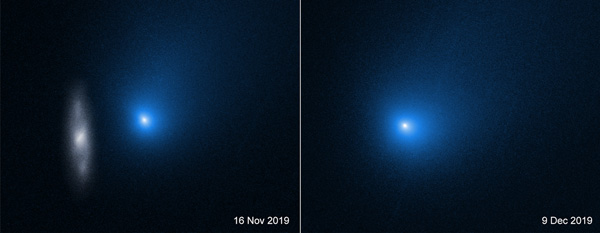The Hubble Space Telescope imaged the interstellar Comet 2I/Borisov when it came closest to the Sun in its hyperbolic orbit that takes it in and back out of the solar system.
Comet 2I/Borisov has remained dim for backyard telescopes, though a few large amateur telescopes have swept it up. Nevertheless, the interstellar comet is ripe for study using world-class telescopes, including the Hubble Space Telescope, which imaged the comet as it rounded the Sun.
This pair of images from Hubble were taken on November 16th, when the comet happened to pass in front of a distant background galaxy, and December 9th, when Comet Borisov had just passed perihelion and was below the inner edge of the main asteroid belt. The comet’s light is artificially colored blue (it’s actually a grayscale image) to help distinguish detail.

NASA / ESA / D. Jewitt (UCLA)
The newest observations revise earlier estimates of the size of the comet’s nucleus. Hubble still can’t actually resolve the nucleus — the light seen in this image comes from an extended halo of dust, known as a coma, that scatters sunlight. However, the Hubble image can help researchers determine an upper limit: The nucleus is less than a kilometer across.
“Surprisingly, our Hubble images show that its nucleus is more than 15 times smaller than earlier investigations suggested it might be,” says David Jewitt (University of California, Los Angeles). “Knowing the size is potentially useful for beginning to estimate how common such objects may be in the solar system and our galaxy.”
The comet is traveling fast, reaching a maximum speed at perihelion of 45 km/s (100,000 mph). By mid-2020, Borisov will already be past Jupiter’s orbit on its way out of the solar system.
 7
7









Comments
Zubenelgenubi 61
December 14, 2019 at 5:34 pm
Reports have 2I at the expected 15th magnitude, and it has been seen visually by at least a couple of amateurs using large telescopes. I don't think it will get down to the 10" telescope level, but this article needs to be revised.
You must be logged in to post a comment.
Monica YoungPost Author
December 16, 2019 at 9:03 am
Revised accordingly. Nevertheless, as you say, it remains out of reach of most backyard telescopes.
You must be logged in to post a comment.
Mark James
December 14, 2019 at 7:58 pm
45,000 km/s? That's 0.15c! Methinks you might be three orders of magnitude off.
You must be logged in to post a comment.
overhaul
December 16, 2019 at 1:17 am
exactly. It's 45m/s, not km/s.
You must be logged in to post a comment.
overhaul
December 16, 2019 at 1:19 am
sorry
*45 000m/s not 45m 🙂 It's early over here.
You must be logged in to post a comment.
Monica YoungPost Author
December 16, 2019 at 8:29 am
Yes that's right, it should have read 45 km/s. Typo fixed.
You must be logged in to post a comment.
Martian-Bachelor
January 3, 2020 at 3:21 pm
If it was just inside the main asteroid belt at perihelion then that means it had to go "through" the belt twice, once on the way in and once on the way out. Since it's path is not in the ecliptic I suppose the odds of it hitting anything are pretty small, but not zero. With such a small size any effect would be magnified, so maybe an impact with even just a 10 meter sized rock would do something dramatic. Hopefully it's under constant monitoring so something like this isn't missed.
You must be logged in to post a comment.
You must be logged in to post a comment.